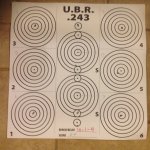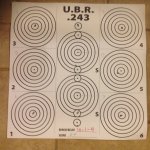Randy,
I have noticed the same. It would seem that a lot of shooters would like to go home thinking "I would have won, but I got creedmored," rather than realizing that they just didn't shoot well that day. As if it would be fine if all the scores were perfect and a coin flip determined the winner. In handgun silhouette, they have gone to half-sized targets, at least for some of the classes.
I remember some discussions leading up to the initiation of UBR. My thought was that a multi-ring reticle, which as Mike pointed out was not available at the time, would avoid the issue of having to stock multiple targets. What if someone wanted to shoot 6.5 mm or 7mm or 20 caliber? Three different targets is one thing, but truly caliber neutral targets for every possibility could be overwhelming. On the other hand, centering an oddball caliber in a 22, 6mm or 30 ring would be a natural thing. An extra reticle for the oddballs might work, too. Still, UBR has changed the game from one in which anything smaller than a 30 is at a disadvantage, to one in which anything other than a 22, 6mm or 30 is at a disadvantage. In the grand scheme, that is a positive change.
It may have been Rick who asked me if I was willing to make and sell such reticles. By not being forthcoming with reticles, I perhaps share the blame for any deficiencies that may be perceived in UBR. And Danny deserves the credit for taking the bull by the horns and actually doing something.
A possible disadvantage of the multi-ring reticle that was mentioned is that the reticle might have to be used on more targets. Rick can correct me if I am wrong, but scoring on UBR targets is not much different from IBS targets, typically involving the reticle on only a few targets for an entire relay. The eye gets pretty good at judging whether the hole touches the ring. But it may be more difficult to judge whether, say, a 22 caliber hole touches the ring when scored with a 30 size reticle. Thus the reticle might have to be used on more targets, thereby slowing down scoring. How much is hard to say without actually trying it for a few matches.
One thing that I find it hard to get used to is the perfect score of 264. If one were designing a new game from scratch, a nice round number for the perfect score would be good. For instance, scoring the dot as a ten would change the UBR perfect score to 240. Or reducing shots to 20 per yardage, to 200. With half-sized bulls, 10 or 12 bulls might be fit on one target, so that only one target change would be needed per yardage. By eliminating several target changes and perhaps a few shots, one-day 100, 200, 300 yard matches would be easier to run (on ranges where these distances are possible), which I think could attract even more shooters.
None of this is meant to criticize Rick or anyone else holding UBR matches. Rick puts on matches that are second to none, and is a big part of why UBR has been so successful.



